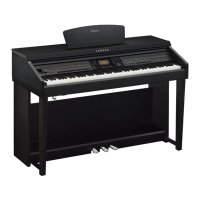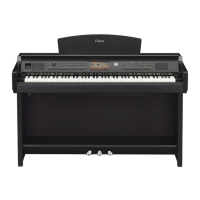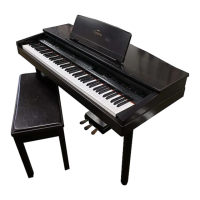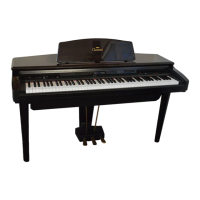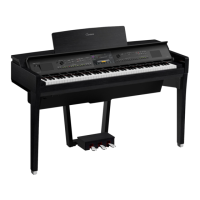Do you have a question about the Yamaha cvp-701 clavinova and is the answer not in the manual?
Details on defining characteristics of different Voice types like VRM, Natural!, Live!, and S.Art!.
Procedure for calling up GM&XG, MegaVoices, and other Voices via panel operation.
How to adjust reverb and chorus depth for VRM compatible Piano Voices.
Procedure to adjust the tuning curve and key-off sound volume for Piano Voices.
How to confirm key assignments for compatible Drum Kit Voices in the Drum Kit Tutor display.
Explanation of Harmony/Echo types and their application to right-hand performance.
Settings related to pitch, including fine-tuning, scale tuning, and transpose button assignment.
Selection of various scales for custom tunings for historical periods or music genres.
Determining which part (keyboard, Song, or both) the TRANSPOSE buttons affect.
Creating custom Voices by editing parameters of existing Voices and saving them.
Adjusting footage levers, attack sound, effects, and equalizer for Organ Flute Voices.
Overview of functions accessible in the Style playback display.
Using the right-hand section for chord input while playing bass with the left hand.
Using the Repertoire function to find suitable songs and call up panel settings.
Registering favorite panel settings to create original One Touch Settings.
Checking the information of One Touch Settings assigned to the currently selected Style.
Creating or editing Styles using methods like Realtime Recording or Style Assembly.
Creating a Style by recording individual channels one-by-one using realtime recording.
Composing a performance by entering notes one event at a time with precise timing.
Creating a Style by mixing patterns (channels) from existing internal Styles.
Adjusting swing or changing the beat feel by shifting the timing (clock) of the Style.
Editing channel data such as quantizing, velocity change, and bar copy.
Setting parameters for Style File Format (SFF) to create custom Styles.
Adjusting settings for music notation display, including left/right hand parts and chords.
Playing back a Song with Style accompaniment, using chord input.
Detailed settings for playback: repeat mode, channel assignment, and guide function.
Using keyboard guide lamps and functions like Follow Lights or Any Key for practice.
Playing backing parts with Song playback, where correct notes are sounded regardless of input.
Recording a Style performance to channels 9-16, then a melody to channel 1.
Procedure for saving the recorded performance as a file in the Song Selection display.
Creating original Songs via Realtime or Step Recording, and editing detailed parameters.
Entering melodies note by note with precise timing using the Step Record function.
Recording chord changes and sections one at a time with precise timing.
Overwriting a specific section of an already recorded Song using the Punch IN/OUT function.
Recording current Mixing Console and panel settings to the Song's top position as Setup data.
Applying functions like Quantize and Transpose to already recorded data on the CHANNEL page.
Editing various events like chords, notes, system exclusive, and lyrics in the Event List display.
Setting and saving parameters for microphone sound, for singing (Vocal) and announcements (Talk).
Procedure for saving microphone settings (VOCAL/TALK pages) as a single file to internal memory.
Detailed settings for the VOCAL page, including 3-Band EQ and Noise Gate.
Detailed settings for the TALK page, including TALK MIXING, Compressor, and Reverb.
Registering files (Song, Audio, Style) into Music Finder for convenient access.
Recalling registered Song, Audio, or Style data from Music Finder.
Creating custom folders of favorite records for quick access to panel settings and song data.
Editing existing Music Finder records, including song name, keyword, tempo, and genre.
Saving Music Finder records (presets and created) as a single file for future recall.
Procedures for deleting or renaming registrations within a Registration Memory bank.
Viewing information about Voices and Styles memorized to Registration Memory buttons.
Freezing specific items (e.g., Voices, effects) to keep them unchanged when switching setups.
Programming and using a sequence to call up Registration Memory setups in a specified order.
Storing the sequence order and behavior settings as part of the Registration Memory Bank file.
Adjusting panning and volume for each part (keyboard, Style, or Song channel).
Procedure for changing the Voice for each keyboard part, Style channel, or Song channel.
Adjusting harmonic content and brightness of the sound for each part.
Adjusting portamento time, pitch bend range, octave, tuning, and transpose settings.
Selecting and setting up various effect types (Reverb, Chorus, DSP) for different blocks and parts.
Editing effect parameters, including variations, for creating custom effects.
Adjusting EQ parameters for high and low frequency bands for each part.
Selecting preset Master EQ types or creating and saving custom EQ settings.
Adjusting parameters for the Master Compressor to limit and compress dynamics.
Saving edited Master Compressor settings as a User Compressor type.
Settings for footswitches and foot controllers, including assigning functions to pedals.
Detailed procedure for assigning functions to the instrument's three piano pedals or AUX pedal.
Connecting the instrument to an iPhone/iPad via a wireless network using a USB wireless LAN adapter.
Setting up and connecting to a wireless network using Infrastructure Mode.
Setting up and connecting to a wireless network using Ad Hoc Mode.
Making MIDI-related settings, including selecting pre-programmed templates and editing them.
Description of available pre-programmed MIDI templates for various applications.
Determining which parts send MIDI data and over which MIDI channel the data is sent.
Determining which parts receive MIDI data and over which MIDI channels the data is received.
Determining the bass note for Style playback based on received MIDI note messages.
Determining the chord type for Style playback based on received MIDI note messages.
Global settings for CONFIG1, including fade in/out, metronome, and power options.
Adjusting metronome volume, sound, and time signature.
Setting drum sound and velocity for the Tap function.
Setting the time before the power is automatically turned off.
Adjusting the brightness of the instrument's LCD screen.
Global settings for CONFIG2, including speaker and voice category button options.
Determining whether speakers sound and managing headphone output.
Settings for how Voice Selection display opens and whether voice numbers are shown.
Locking specific parameters to prevent changes via Registration Memory or other functions.
Executing USB media-related operations like checking memory or formatting.
Setting owner name, display language, and instrument version.
Procedures for backing up and restoring instrument settings and data.
Saving and recalling original settings as a single file for future use.
Restoring the instrument's status to the original factory settings.
| Amplifiers | 25W x 2 |
|---|---|
| Pedals | Damper (with half-pedal effect), Sostenuto, Soft |
| Polyphony | 256 notes |
| Touch Sensitivity | Hard/Medium/Soft/Fixed |
| Voices | 29 Drum/SFX Kits |
| Display | 4.3 inch LCD |
| Speakers | 16cm x 2 + 5cm x 2 |
| Recording | 16-track |
| USB Audio Recorder | Yes |
| Effects | Reverb, Chorus, DSP, Master Compressor, Master EQ |
| Songs | 50 preset songs |
| Connectivity | Headphones, MIDI In/Out, AUX In/Out, USB to Host, USB to Device |
| Included Accessories | Owner's Manual |
